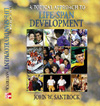 |  Life-Span Development: A Topical Approach John W. Santrock
Social Contexts of Development Peers and the Sociocultural World
Learning Objectives1.Understand the functions of peer groups as a means of social comparison and a source of information beyond the family, noting that good peer relations may be necessary for normal social development, but peer relations may have both positive and negative developmental outcomes. |
 |  |  | 2.Explain how healthy family relations promote health peer relations, with peer relations taking place on a more equal basis than parent-child relations, and seeing that the time spent in peer relations increases throughout childhood and adolescence. |
 |  |  | 3.Describe the four important peer statuses (popular, neglected, rejected, controversial) and the impact of being rejected on a child's development, as well as understanding the increasing concern about bullying and its links to aspects of parent-child and peer relations, and how social cognition pertaining to peers has focused on information-processing skills and knowledge. |
 |  |  | 4.Discuss the functions of play, including affiliation with peers, tension release, advances in cognitive development, and exploration, then describe Parten's five categories of social play and how the contemporary perspective on play emphasizes both the social and cognitive aspects of play. |
 |  |  | 5.Consider the functions of friendships in childhood and adolescence, including companionship, stimulation, physical support, ego support, social comparison, and intimacy/affection, addressing Sullivan's argument that the psychological importance of intimacy in adolescence, then thinking about the link between increased problems with having older friends in childhood and adolescence. |
 |  |  | 6.Explore the role of friendships in adult development and aging, especially in providing emotional support, then consider the different characteristics of male-male, female-female, and female-male friendships, noting that regardless of age, friendship is an important aspect of relationships, but in old age there is often more change in male than in female friendships. |
 |  |  | 7.Discuss the issues of peer relations in adolescence, including:- The pressure to conform to peers is strong, especially during the eighth and ninth grades to antisocial peer standards.
- Most secondary schools have three to six well-defined cliques, and membership in some of them is linked with self-esteem.
- Youth organizations can have an important influence on adolescent development.
|
 |  |  | 8.Describe the various elements of aging and the social world, such as:- The theories of aging that have or have not held up (e.g., disengagement theory, activity theory, social breakdown/construction theory) and how ageism is a common occurrence.
- Social support is an important aspect of helping people cope with stress, although older adults usually have less integrated social networks and engage in less social activity than their younger counterparts.
- Respect for age varies across cultures, with status depending on such things as the perception that the elderly have valuable knowledge to the belief that they serve useful functions
- The positive aspects of aging are increasingly being studied, and successful aging is linked to an active lifestyle, positive coping skills, good social relationships and support, and self-efficacy.
|
 |  |  | 9.Expound on the sociocultural influences of development, including:- Culture is an important aspect of life-span development and incorporates such concepts as individualism and collectivism, rites of passage, and its connection with aging.
- Socioeconomic status is the groups of people with similar occupational, educational, and economic characteristics, with a special concern that focuses on poverty.
- Ethnicity is based on cultural heritage, nationality characteristics, race, religion, and language, noting the importance of teasing apart SES and ethnicity, differences and diversity, aging minorities, and America as a nation of blended cultures.
|
|



 2002 McGraw-Hill Higher Education
2002 McGraw-Hill Higher Education